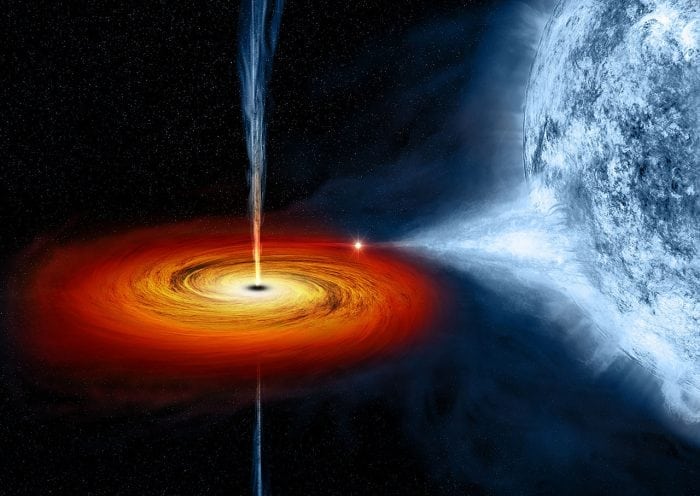
Of all the strange kinds of things discovered in our universe, black holes probably take the cake for simultaneously being one of the most fascinating and most terrifying. Just the name “black hole” has an ominous feel to it. These cosmic holes in the spacetime fabric form after a sufficiently massive star goes supernova and collapses in on itself. The gravitational field of a black hole is so strong that nothing can escape its grasp.
Given that not even light can break free of its gravitational pull, black holes are impossible to observe directly. Instead, scientists look for the surrounding effects of a black hole, such as the strange movement of stars influenced by its gravitational field or points in space that exhibit massive pulses of energy.
Sometimes if you’re lucky, you can catch a black hole eating a snack as it sucks up cosmic dust and gases. Such is the story told in a study published earlier this month for the Royal Astronomical Society, where a team of astronomers from the UK report the real-time observation of matter being sucked into a black hole at 30% the speed of light.
The observed black hole activity is localized in the center of the Seyfert galaxy PG1211+143. It is commonly accepted among astrophysicists nowadays that at the center of most galaxies is a supermassive black hole that serves as the galactic “core.” Using data from the XMM Newton, a massive X-ray telescope launched and maintained by the European Space Association, the team of researchers trained their eyes (or computers) on the galactic core of PG1211+143, an object more than 1 billion light-years away. What they found was a significant red shift in the observed spectra emanating from the galactic core, indicating that the observed matter was receding away from them very rapidly. Via calculation, the researchers determined the matter to be falling into the core supermassive black hole at a velocity of 30% the speed of light (~100,000 km per second). What’s more, the data showed the trajectory of the ultra-fast falling matter to be almost a straight line instead of a curve guided by the accretion disk, a confirmation of recent theoretical work done on the dynamics of black holes.
How To “See” A Black Hole
As stated previously, not even light can escape a black hole, so scientists have to use indirect means to observe them. One way to do this is by measuring the amount of redshift or blueshift in the received spectra of light from regions around the black hole. You take a telescope and point it at the region of space you want to look at. You measure the incoming light, then you check to see if that light signal has been distorted by being stretched or smushed. If the incoming wavelengths have been stretched (redshift), then that is evidence that the body emitting light is moving away from you rapidly. Conversely, if they are smushed (blueshift), then that is evidence the body is moving towards you. Depending on the exact character of the wavelength shift, scientists can extrapolate what mechanisms are responsible for the shifting, be it the expansion of the universe or the gravitational activity of a nearby black hole.
With the measurement technique in mind, the team of researchers poured over mountains of x-ray data taken by the XXM Newton during its 2014 observations of PG1211+143. What they found was significant redshifting in the spectral data gathered from XXM Newton’s 2659th revolution. The team calculated an overall redshift of 0.48±0.01, indicating that the source of the emitted light was receding from the observers at a rate of 0.3c. Additionally, it was estimated that the body of mass was extremely close, at about a distance of 20 times the hole’s size. Analysis of data taken from subsequent orbits of XXM Newton showed the continued redshift of the spectral lines, providing evidence that the team was looking at a body of matter that was continuously being sucked into a black hole.
Perhaps most interesting was that the infall trajectory of the absorbed matter was almost a straight line. Previous thought held that the accretion disk of a black hole rotates in the same direction as the black hole itself does. So if any matter were to fall in, it would follow the general curved orbit as it slowly sank in. However, recent theoretical work on the dynamics of the black hole accretion disks indicates that misalignment of the accretion disk to the rotation fo the black hole can cause the accretion disk to “break” into a number of unstable smaller discs. These smaller discs can collide with each other and cancel out any momentum of their constituent particles, allowing the gas and particles to fall into the supermassive black hold in a relatively straight line. The current observations seem to confirm these theoretical predictions.
The researchers are confident that their data offers unambiguous direct evidence for ionized matter converging on a black hole. Moreover, their data provide evidence of large-scale accretion disk tearing, with ultrafast line-of-sight inflows of matter being the result. “We were able to follow an Earth-sized clump of matter for about a day, as it was pulled towards the black hole, accelerating to a third of the velocity of light before being swallowed up by the hole.” lead researcher Ken Pounds told Phys.org.
The researchers also argue that chaotic accretion disk activity in black holes could allow them to accrue mass more rapidly. The halting of particle momentum from disk collisions would slow the black hole’s own rotation, allowing more gas and particles to fall in. Such a mechanism could be behind the theorized rapid growth of black holes in the early universe.









